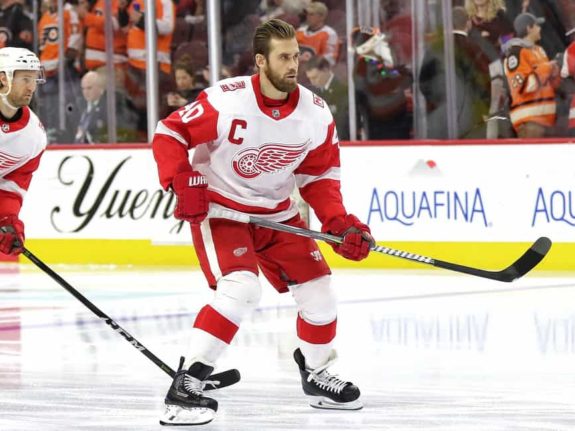The Detroit Red Wings are incredibly stingy when it comes to retiring numbers. To date, they have only retired eight jerseys with the recent inclusion of Red Kelly’s number 4. This isn’t necessarily a bad thing — retiring a jersey is an honor reserved for the greatest of the greats in team history.
For an Original Six team like the Red Wings, there are many players worthy of seeing their number raised to the ceiling of Little Caesar’s Arena. The player with the most traction right now is Sergei Fedorov, with former general manager Ken Holland stating as far back as 2015 that the organization was looking into honoring the forward’s legendary number 91. But for an organization that clearly prioritizes loyalty as a prerequisite for earning that honor, one forward stands out to me: Henrik Zetterberg.

Though his contract is still on the team’s books for another year, Zetterberg has been out of the league for two seasons now. Across 15 seasons with the Red Wings, the native of Njurunda, Sweden put together a career that immortalized him in the hearts of many fans throughout the league. It’s because of this and so much more that the Red Wings should raise the forward’s number 40.
Former Captain
On Jan. 15, 2013, before the beginning of the abbreviated 2012-13 season, the Red Wings named Zetterberg as the 36th captain in team history. He wore the “C” on his jersey for five seasons, before his premature retirement in 2018. It took until 2021 for them to name a new captain: Dylan Larkin.
Across the eight players who have had their jerseys retired by the Red Wings, seven of them have been captains of the team. The only one who hasn’t is Terry Sawchuk, one of the best goalies of all time. Zetterberg’s immediate predecessors, Nicklas Lidstrom and Steve Yzerman, both have their jerseys retired.
Related: Little Known Facts About the Stanley Cup
It’s obviously a big deal to wear the captain’s “C” for any team in the league — it’s why the Vegas Golden Knights have yet to name a captain for the first time in their team’s existence. One could argue that it’s an even bigger honor to captain one of the Original Six teams, and Zetterberg did just that for half a decade. Heck, when Yzerman retired, Zetterberg was the only player besides Lidstrom to receive consideration to take over for “The Captain.”
A Player For the Ages
Gordie Howe sits fourth all-time in league scoring. Yzerman sits seventh. Lidstrom is tied for the second-most Norris Trophy victories of all time with seven.
Zetterberg’s personal accolade list is much less illustrious. While 960 career points is still an impressive total, it’s nothing when compared to the all-time greats. He never won the Hart Trophy as the league’s regular season MVP. In fact, the only regular season award he won was the King Clancy Trophy in 2015, an award given to the player who best exhibits leadership on and off the ice.

Where Zetterberg really cemented his legacy was during the 2008 Playoffs. His legendary penalty-kill shift during Game 4 of the Stanley Cup Final against the Pittsburgh Penguins was one for the ages.
That shift would go on to be called the “Conn Smythe Shift” among Red Wings fans. On a team with Lidstrom, Pavel Datsyuk and Chris Osgood, Zetterberg’s performance stood out the most, earning him the Conn Smythe Award as the playoff MVP. This playoff run earned him a reputation throughout the league as one the NHL’s premier defensive forwards.
Loyalty
How does one measure loyalty in an industry where people can move to another city at a moment’s notice? After all, the reason Fedorov’s jersey hasn’t been retired is because he signed an outrageous offer sheet with the Carolina Hurricanes in 1998, and then left the Red Wings in free agency to join the Mighty Ducks of Anaheim in the summer of 2003.
You measure it by a 12-year contract awarded to Zetterberg in 2009, the longest deal in team history. Though it hampered the team’s financial flexibility the last few years, he gave the organization nine solid years under that deal. This is especially impressive given the conditions that came with the latter half of those nine years.
After the second-round heartbreaking loss to the Chicago Blackhawks in the 2013 Playoffs, the Red Wings saw diminishing returns, leading to the end of the team’s 25-year playoff streak. While battling through crippling back pain, Zetterberg faced the media night in and night out as his team slipped further and further into obscurity. When he was forced to hang them up due to his condition, it signaled the true end of an era for the franchise.
The Face of a Franchise
Zetterberg and his linemate Datsyuk defined Red Wings’ hockey for nearly a decade. They took the torch from the likes of Yzerman and Brendan Shanahan and carried it into the “new” NHL. While Datsyuk won the awards, Zetterberg’s face could be found throughout downtown Detroit — “Hockeytown” as fans affectionately refer to it as.
You may also like:
- NHL Rumors: Oilers, Red Wings, Flyers
- 9 NHL Teams That Missed in Free Agency
- Why Red Wings’ Quiet Offseason Was the Right Call Long Term
- Red Wings Should Still Pursue John Gibson Trade
- Red Wings’ 10 Hall of Famers on 2002 Stanley Cup Team
For a franchise that has been home to the likes of “Mr. Hockey” and “The Perfect Human,” it should mean something when an individual embodies that franchise. Zetterberg, a seventh-round pick in 1999, committed himself to a team located in a city known for adversity. He was never the flashiest player on the ice, but he was always the hardest worker; if that isn’t quintessential Detroit, I don’t know what is.
Related: Best Undrafted Players in NHL History
Across the fandom, the number 40 conjures up memories of one person: Zetterberg. It wouldn’t feel right seeing somebody else wear that number. It’s only right that his jersey number joins that exclusive club of all-time greats to wear the winged-wheel.
